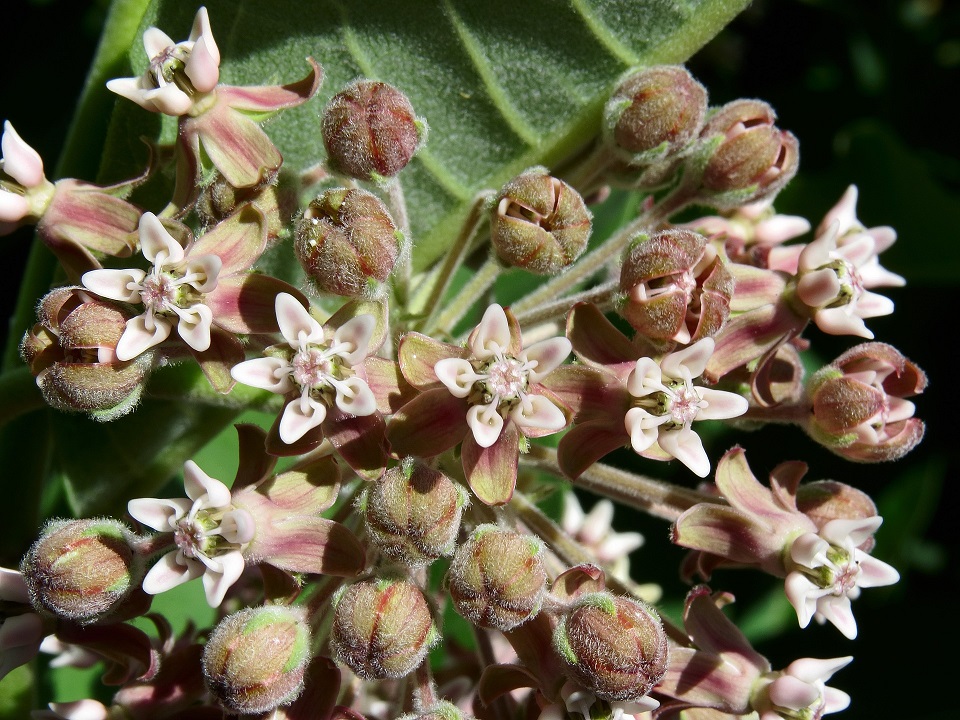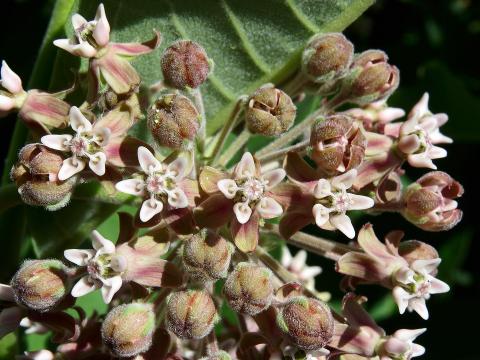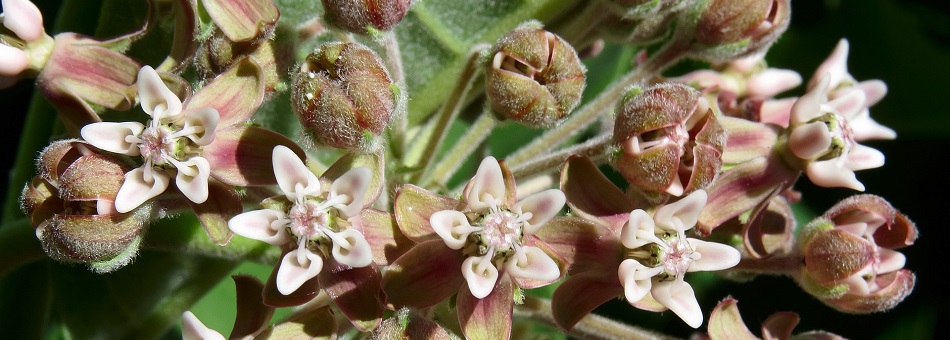The ORNL DAAC produces and archives Daymet, which supplies gridded estimates of daily weather parameters over North America. Below, summaries of three peer-reviewed research articles illustrate how researchers have used Daymet to inform a variety of applications.
Daymet used to evaluate potential effects of climate change on common milkweed
Daymet data were used to improve understanding of the influence climate change has on the phenology of Asclepias syriaca (common milkweed). A. syriaca is a flowering plant native to much of the United States that relies on a variety of insects for pollination. Howard (2018) hypothesized that the phenology of A. syriaca, that is, the timing of the plant's life cycle, has been modified by climate change. The author retrieved daily maximum temperature and precipitation values from Daymet for the locations of A. syriaca individuals recorded in the U.S. National Phenology Network database, and quantified the relationship between climatic variables and the flowering dates of the plants. The results showed that higher temperatures were correlated with earlier milkweed flowering dates.
Phenological studies are important because earlier flowering dates of can lead to "mismatches" between the phenology of when plants flower and when insects are available to pollinate the plant. According to Howard (2018), "Given A. syriaca's potential susceptibility to the negative consequences of phenological shift, recent decline, and importance as a host plant, it is critical to this plants future conservation that its potential response to climate change is investigated."
Publication: Howard, A.F., 2018. Asclepias Syriaca (Common Milkweed) flowering date shift in response to climate change. Scientific Reports, 8(1):17802. https://doi.org/10.1038/s41598-018-36152-2
Daymet aids research on responses of vegetation to climate variability across Yellowstone National Park
Daymet was used in combination with remotely-sensed land products to inform analysis of changes in vegetation across Yellowstone National Park. To identify ecological vulnerability and guide resource management in the Western United States, a region that experiences periodic water scarcity, Notaro et al. (2019) retrieved temperature, precipitation, surface solar radiation, and snow-water equivalent data from Daymet. The authors identified which climate variables varied most across the study area and how those changes related to the health and seasonality of vegetation. In addition, they constructed a timeseries of monthly anomalies of both climate and vegetation variables to demonstrate how vegetation patterns varied across the park in recent decades.
Yellowstone National Park is the oldest official national park in the United States, has a largely pristine environment, and has been the subject of intense environmental research. Through their exploration of the complex interactions between climate and vegetation, Notaro et al. (2019) offer new insights into how climate change is manifest across a variety of topographic, climatic, and ecological gradients.
Publication: Notaro, M., Emmett, K. and O’Leary, D., 2019. Spatio-Temporal Variability in Remotely Sensed Vegetation Greenness Across Yellowstone National Park. Remote Sensing, 11(7):798. https://doi.org/10.3390/rs11070798
The U.S. Geological Survey incorporates Daymet into hydrologic modeling applications
Daymet has been used in configurations of a national hydrologic model that aims to enable more effective water resources planning and management. The U.S. Geological Survey developed the National Hydrologic Model (NHM) infrastructure "to support coordinated, comprehensive, and consistent hydrologic modeling at multiple scales for the conterminous United States." When the model is configured for use in the Precipitation-Runoff Modeling (NHM-PRMS), the model includes precipitation and minimum and maximum temperature derived from the Daymet.
The authors, Regan et al. (2019), describe in Environmental Modeling and Software, that the rationale for the NHM is to provide consistent and relevant simulations of watershed-scale hydrologic processes for effective management of water resources. Moreover, incorporating variations of local parameters into the model can contribute to studies on specific geospatial areas or conditions.
Publication: Regan, R.S., Juracek, K.E., Hay, L.E., Markstrom, S.L., Viger, R.J., Driscoll, J.M., LaFontaine, J.H. and Norton, P.A., 2019. The US Geological Survey National Hydrologic Model infrastructure: Rationale, description, and application of a watershed-scale model for the conterminous United States. Environmental Modeling & Software, 111:192-203. https://doi.org/10.1016/j.envsoft.2018.09.023
Learn how you can use Daymet in your research at https://daymet.ornl.gov/.
Daymet Datasets:
Thornton, P.E., M.M. Thornton, B.W. Mayer, Y. Wei, R. Devarakonda, R.S. Vose, and R.B. Cook. 2018. Daymet: Daily Surface Weather Data on a 1-km Grid for North America, Version 3. ORNL DAAC, Oak Ridge, Tennessee, USA. https://doi.org/10.3334/ORNLDAAC/1328
Thornton, M.M., P.E. Thornton, Y. Wei, B.W. Mayer, R.B. Cook, and R.S. Vose. 2018. Daymet: Annual Climate Summaries on a 1-km Grid for North America, Version 3. ORNL DAAC, Oak Ridge, Tennessee, USA. https://doi.org/10.3334/ORNLDAAC/1343
Thornton, M.M., P.E. Thornton, Y. Wei, B.W. Mayer, R.B. Cook, and R.S. Vose. 2018. Daymet: Monthly Climate Summaries on a 1-km Grid for North America, Version 3. ORNL DAAC, Oak Ridge, Tennessee, USA. https://doi.org/10.3334/ORNLDAAC/1345
Thornton, M.M., P.E. Thornton, Y. Wei, R.S. Vose, and A.G. Boyer. 2018. Daymet: Station-Level Inputs and Model Predicted Values for North America, Version 3. ORNL DAAC, Oak Ridge, Tennessee, USA. https://doi.org/10.3334/ORNLDAAC/1391
Thornton, P.E., M.M. Thornton, and R.S. Vose. 2018. Daymet: Annual Tile Summary Cross-Validation Statistics for North America, Version 3. ORNL DAAC, Oak Ridge, Tennessee, USA. https://doi.org/10.3334/ORNLDAAC/1348



